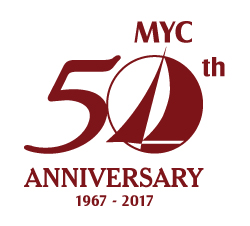MYC 50th anniversary – Trans Tasman Survival
 Former commodore John Bates recalled the story of the Trans Tasman Race. It was a very big year…
Former commodore John Bates recalled the story of the Trans Tasman Race. It was a very big year…
The Trans-Tasman Solo Race has been the source of many tales.
The achievements of MYC members such as Bill Gleeson, Jon Sayer, Peter Mounsey and, in more recent times, Laurie Gubb and Ian Griffith, could make a great chronicle.
However, the year which must stand out in the this history of MYC as being unforgettable was 1978 – the Bill Belcher Year.
During the long period from race start in New Plymouth, New Zealand, until all competitors actually stepped ashore in Australia, the MYC race committee, led by Commodore, Harry Marshall, aged ten years.
Harry was meeting the media head-on with his quietly spoken way, trying to show logic to those who would push panic buttons and go looking for Bill Belcher just because he hadn’t finished in the first three places.
Communications had not been perfect that year by any means. Many competitors had not kept their radio skeds with either NPYC or MYC, so it wasn’t until the first three yachts finished that is was beginning to look like the middle of the fleet had run into pretty dirty weather.
Bill Belcher wrote a book about his ploughing into Middleton Reef, waiting for rescue in his yacht Josephine II, sitting high on the reef and finally taking to his life raft ten days later in the hope of drifting to Australian shores.
In the same race, one yacht was pitch-poled 360 degrees, losing her rig, and another rolled dismasted and abandoned in the Tasman Sea.
The little quarter-tonner Witchetty limped into Mooloolaba with a tiny jury rig and a single-handed sailor who vowed never to sail the Tasman again (he did – twice) Witchetty was befriended by a new MYC member, Alex Higgins, starting a long and meaningful relationship between man and boat.
What of the abandoned boat – a 38ft sloop sailed by one-legged stalwart John Jury. John was taken from his drifting hull by a freighter and the boat abandoned, much to John’s dismay.
It was my habit to escape to Fraser Island when peace and quiet was needed. All solo competitors had been accounted for except Bill Belcher who was still adrift in his life raft.
Four days camping the beach up by Indian Head seemed a great escape from the pressure. So with three friends it was into the four-wheel-drive and off.
Glen Arundell was with his favourite lady (now wife of many years) and I too was with my then favourite.
After setting up camp, we lay back to enjoy the sunset and cold drinks. Not a soul could be seen looking south or north along the beach. (Those were the days!)
Suddenly a news helicopter came screaming past about 50ft off the sand. Glen’s curiosity was greater than mine, so he headed north along the beach.
Not long after dark he returned with incredible news. John Jury’s boat was washed up on the beach a few miles north.
The next day we inspected the hull – together with other campers who had happened on it.
John Jury had been in Mooloolaba and was soon on board a fellow competitor’s yacht, heading north to claim his hull.
Mid-afternoon next day the yacht hove-to about a mile off the beach and a dingy could be seen rowing for our position.
Being on the sand side of the shore break, we could see that a surf boat might have had a chance of getting through the breakers but for a one-legged man in a dingy it was a bit risky.
Glen – being the fit waterpolo player – started swimming.
He met the upturned dingy and the mono-pedestrian, now aquarian, about 200m out. We in turn met the rescue party about halfway back and all reached the beach in safety.
Glen was awarded the BRM (Bundaberg Rum Medal) for bravery, plus, to his delight, boat chandlery from John Jury which would assist greatly his own boat-building project.
A news helicopter reappeared and we were informed by the news crew that Bill Becher had been picked up off Gladstone, frail but well after 28 days in his raft and some 300 nautical miles from the reef.
Yes, 1978 was a big year for MYC.
In October the same year the MYC Yacht Odyssey sailed north from Mooloolaba and returned from the south having kept Australia on the left and not stopping or using any power other than the wind. It was the first non-stop circumnavigation of Australia – but that is another story.
- John Bates was Rear Commodore in 1978 and 1979, Vice Commodore in 1980 and Commodore 1981 and 1982.